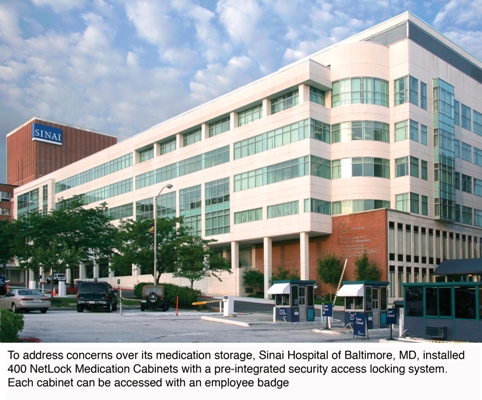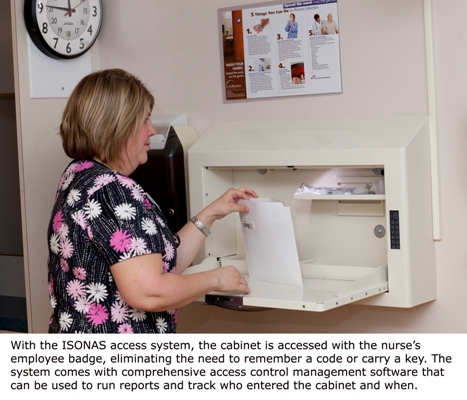Medical Facilities Protect Against Unauthorized Access
There are numerous areas to secure in today’s medical facilities. Outside doors, of course, must offer protection against unauthorized access by patients, visitors, employees and outsiders. Similarly, doors to wards, rooms and offices must be safeguarded. But that is only the beginning of the story. There is also a growing need to restrict access to medicine storage cabinets, medicine carts, computers, medical records systems, ambulances and even parking lots.
Failure to monitor these areas can lead to equipment or prescription drug theft, employee assaults, mistakes with patient medications, confidential patient information being compromised or even ambulances being entered without permission.
But it is the sheer number of doors and cabinets within a medical facility that makes this a complex issue. What is required is a means of controlling access at any and all of these points despite thousands of employees that have different job duties, restricted areas, and work hours. Fortunately, with today’s access control systems, this can best be achieved via the establishment of an integrated system, one that can run off a medical facility’s existing IT network.

Access Control Systems – Simplified, Less Expensive
Although video surveillance camera systems have been IP-based for many years – meaning they are connected directly into existing IT networks using standard cabling – the access control industry initially lagged behind in transitioning to this technology.
In fact, until recently video surveillance and access control systems were installed completely independently and custom software often had to be created to allow communication and integration between systems or even with an IT network.
“Until a few years ago, security cameras and access control systems were completely separate and often proprietary,” states Charles Crenshaw, CEO of ISONAS Security Systems, one of the first companies to develop IP-at-the-door reader-controllers. “This meant incompatible installations, separate management software and multiple maintenance contracts.”
Fortunately, today’s access control systems are increasingly IP-based. By piggybacking on the existing network and its cabling, facility managers and security personnel can quickly and easily install door access readers to a common network switch with standard cables.
If the network switch has a built-in Power over Ethernet (PoE) feature – a common feature – it can even supply power to door access readers through the CAT-5 cabling, with no need to tap into building power. Comprehensive access control management software is then used to manage an unlimited number of readers from a single, web-enabled interface.
“IP-based access control systems reduce installation costs. That, combined with the continuing reduction in the cost of door access readers means the ‘cost per door’ has dropped significantly over the past 5 years,” says Crenshaw. “It is also much more scalable, so it’s very easy to start in one area and expand into other areas as needs expand or funding becomes available.”
Securing Doors
In 2010, Moundview Memorial Hospital & Clinics in Wisconsin decided to upgrade its physical security infrastructure with a new, IP-based access control system. Moundview Memorial provides 24-hour emergency care, clinic, inpatient care, outpatient services, diagnostic testing, surgical procedures and senior services.
According to Jim Franckowiak, Moundview Memorial’s Director of Information Technology, the previous attempt at access control involved a series of keys that were shared by individuals that need to enter important operational locations within the hospital.
“We routinely found ourselves having to track down keys and replace not only keys but locks as well if the keys were lost or if an employee left and forgot to turn their keys in,” explains Franckowiak.
His criteria in selecting an upgraded system included ease of installation, complete access control functionality include the ability to remotely lock down a controlled area if necessary, and the ability to manage the system via a web browser using a computer, tablet or Smartphone. He found these features in the IP-based system offered by ISONAS Security Systems.
“Having web access to the system I can access remotely, or from my iPad, is very convenient since it allows me to provide access to any door in the system no matter where I am at the moment,” said Franckowiak.
The system was initially deployed in a medical supplies storage area and later expanded to additional departments including the pharmacy, the IT server room, the emergency treatment facilities, and the mail room.
Installation of the hardware was done by in-house maintenance personnel that installed the low voltage CAT-5 cabling, the ISONAS PowerNet reader-controllers and the other door hardware such as locks and sensors. The IT department configured the management software.
Today, the system provides administrators at Moundview Memorial with accountability that was not previously available since the system automatically logs the identity of each person entering a door or accessing a facility along with the time of entry.
“Superior physical security applied to the security realities of today’s healthcare facilities environment is what we were after,” says Franckowiak. “And that’s what we got.”
Medication security
Every year in American hospitals approximately 400,000 patients become ill or injured as a result of a medication error. In as many as 7,000 of these cases the final outcome is death. With liability costs averaging more than $600,000 per incident, many hospitals are addressing shortcomings in its medication dispensing process.
At Sinai Hospital of Baltimore, MD, an area of concern was its medication storage. Nurses had to make repeated trips to a medication cart located in the hallway to pick up medications. With twenty or more cart doors and an unreliable, antiquated manual lock system, personnel struggled to maintain security.

Under the direction of Sinai Hospital patient care director Bonnie Hartley Faust, MS, MBA, RN, Sinai Hospital selected and installed 400 NetLock Medication Cabinets from Cygnus Inc. pre-integrated with a security access lock system from ISONAS. Each cabinet can be accessed with an employee badge, thus eliminating the need to remember a code or carry a key.
Using management software, reports are used to track who entered each cabinet and when. Any cabinet can be individually assigned access privileges for that location. For example, nurses and pharmacy staff can be allowed access to a defined list of cabinets and floors limited by specific hours. In addition, pharmacy personnel who stock cabinets can be assigned access at pre-defined time periods.
Securing other areas
Door access readers can now also be installed inside a fleet of ambulances that are either run by, or partnered with a hospital. In doing so, the access system’s management software can be updated to grant access to the EMTs that operate ambulances. Wireless technology can be used to automatically update the ambulances when they are parked in front of the hospital.
Parking lots is another application that may be of interest to a medical facility. Installing a centralized access control system and long-range readers at parking facilities reduces parking conflicts and makes it easier for the hospital personnel to enter the parking lots.
Not all of these areas, though, would necessarily come under the same person’s direct control, says Crenshaw. For that reason, the access control system’s management software has the ability to give administrators control over different portions of the system i.e. in-room cabinets might be monitored by a nursing department, the data center by the IT staff, and building entrances and parking access by the security group.